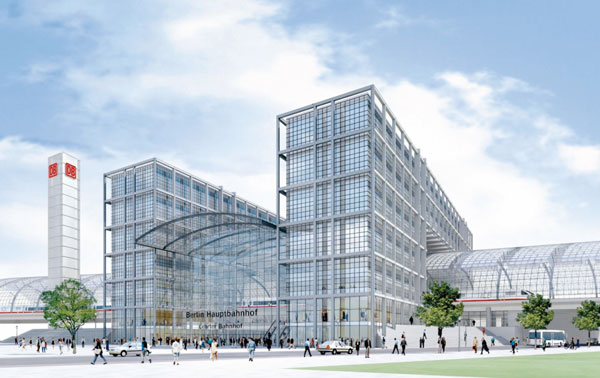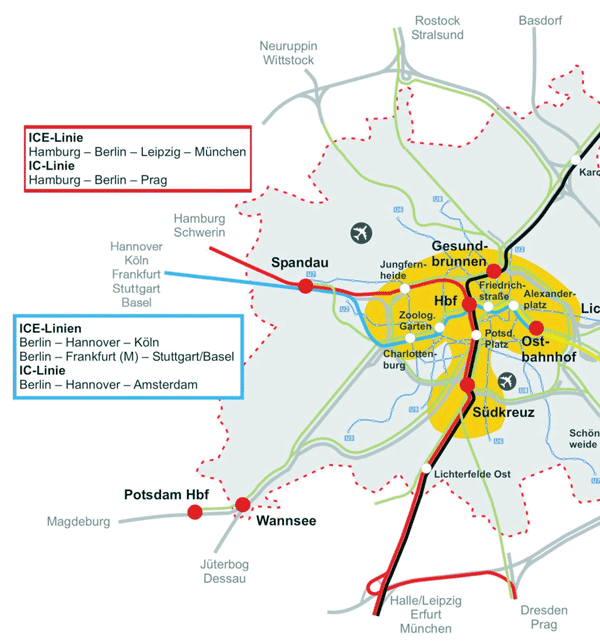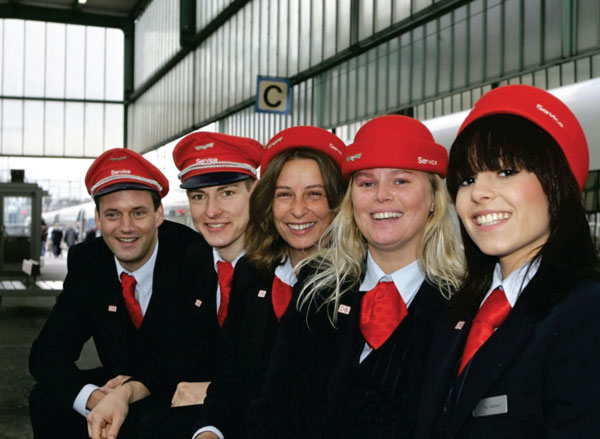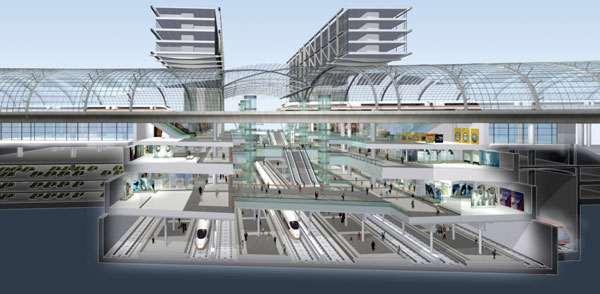Germany’s ‘Central Station’
Posted: 3 April 2006 | | No comments yet
Travelling, shopping, dining – Berlin Hauptbahnhof (Berlin Central Station) opens its doors at the end of May as Europe’s largest crossing station. Right on time for the FIFA World Cup Germany 2006™, Europe’s largest and most modern crossing station will be connected to the network on 28 May: Berlin Hauptbahnhof – Lehrter Bahnhof. Not only […]
Travelling, shopping, dining – Berlin Hauptbahnhof (Berlin Central Station) opens its doors at the end of May as Europe’s largest crossing station.
Right on time for the FIFA World Cup Germany 2006™, Europe’s largest and most modern crossing station will be connected to the network on 28 May: Berlin Hauptbahnhof – Lehrter Bahnhof. Not only does Berlin gain a worthy welcoming structure for travellers and visitors, but the capital city of Germany acquires a ‘Central Station’ for the first time ever. It is located in the new centre of Berlin, in the immediate vicinity of the Federal Chancellery, the Reichstag and the Brandenburg Gate. This impressive transportation structure rounds off the ensemble of new and historic buildings in the Government Quarter. Berlin Hauptbahnhof will not only be a landmark for the city, it will also significantly shapes the image of the international mobility and logistics service provider, the Deutsche Bahn (German Railway).
The North-South Connection
Stations provide visitors with their first and last impressions. As showcases for cities and towns, stations are of central importance to their image and identity. Often situated in historic town centres, they are also centres and meeting points for local residents. This is particularly true for the 2,400 or so stations that have their own passenger buildings, (Figure 1), (there are a total of 5,400 stations and stopping-places in Germany). Berlin Hauptbahnhof’s location, between the two traditional centres in the East and West of the old and the new capital city, is sufficient to lend particular significance to the station, closing a last gap, so to speak, between the two halves of the city.
However, the station is not just an individual railway station. It represents the core of a new transportation concept in Berlin. This became necessary after the reunification of Germany. The development of Berlin into a metropolis of European dimensions once again, together with the need to adapt the railway infrastructure in the centre of Europe to the challenges of the future, made the project for the North-South Berlin connection for long distance and regional traffic possible for the first time. From 28 May 2006, trains coming from the South will be able to reach the stations Berlin Südkreuz (‘southern junction’ formerly called Papestrasse), Potsdamer Platz and Berlin Hauptbahnhof before continuing on their journey northwards through Berlin towards Gesundbrunnen station or to Berlin-Spandau. The stations Südkreuz, Potsdamer Platz and Gesundbrunnen will also become operational on 28 May 2006 (Figure 2).
Even in the earliest deliberations, the area to the north of the Spreebogen (a curve of the River Spree) next to the Humboldthafen port assumed the position of traffic hub. It was there that the existing East-West railway should meet the North-South connection. This is where, as a matter of interest, the Lehrter Bahnhof served as a traditional terminus for connections towards Hanover and Hamburg between 1871 and 1959. Due to the damage caused in the Second World War and to the changes in traffic routes resulting from the division of Germany, it was decided in 1951 to close the station and in 1987 to demolish the ruins of Lehrter Bahnhof. The North-South Berlin connection that was given planning permission in 1995 brought with it a new, special significance for the ‘Lehrter City Quarter’, as it has been known up to now. All long-distance trains that start in Berlin, or that run in the East-West direction, will stop at the Berlin Hauptbahnhof traffic hub. The North-South connection tracks lie 15 metres below ground level and the East-West connection tracks lie 10 metres above the level of the road. At the same time, the Central Station is also the centre of the Regionalbahn network (regional rail) and the S-Bahn network (urban rail). Thus, the entire metropolitan region is opened up to the traveller and the Berlin residents.
A new landmark for Berlin
With its unique, transparent and functional architecture and its spectacular structure made of concrete, steel and glass, the Central Station will be a new landmark for the Deutsche Bahn and for Berlin – particularly at night. The Hamburg architects von Gerkan, Marg & Partner planned and designed this impressive transportation structure. It is visible from a long way away – and to a great extent – this is attributable to the station roofs. The East-West roof is a modern, high-tech structure. It is approximately 320 metres long and spans the six S-Bahn tracks. The tracks follow the gentle curve of the River Spree. Thus the roof structure was also designed in a curved form. It is up to 16 metres high and between 59 and 68 metres wide. A photovoltaic system is integrated in the southern side of the East-West roof. The solar panels cover an area of approximately 1,200 m2 and generate the equivalent amount of electricity that would supply 40 detached houses.
Two office buildings extend over the top of this roof: the so-called arched structures, which are 50 metres high. They were cantilevered into position last summer, in a high-profile operation. Tens of thousands of onlookers, both Berliners and tourists, followed the progress of the arched structures over two weekends as they were lowered into place. At a speed of six metres per minute, this high-tech procedure was hardly noticeable to the eye. First of all, four towers – two on the northern and two on the southern side of the East-West roof – were pre-assembled and built upwards. Each tower had a vertical bridge section that could be pivoted into a horizontal position, similar to a bascule bridge. When the towers reached a height of approximately 70 m, the bridge halves – each weighing around 1,250 t – were pivoted at the base and lowered, drawbridge-style, until they reached their final horizontal position spanning the East-West roof. The two halves of each bridge were then joined together, thus creating – from the four separate sections – the two bridges that now span the East-West glass roof like square arches. The engineering methods used during the construction phase enabled the East-West railway traffic, with over 350 long-distance and regional trains running daily in addition to the four S-Bahn lines, to continue operating smoothly with only two weekend track possessions. Today, the alignment of the 180 metre long, twelve-storey, arched buildings reflects the route of the North-South railway lines that run below the ground.
The two buildings together provide a total gross floor area of 42,000 m2. Another glass roof was erected between the two arched structures: the 210 metre long North-South roof. It spans the station concourse, which is approximately 40 metres wide. Both parts of the building are connected at high level via two skywalks. They cross through the passenger hall, so to speak.
Meanwhile, the largest and most important construction measures have been completed. The railway is now preparing itself for the 28 May 2006. The final spurt is on, because by then the Central Station has to be ready to greet guests from all corners of the world.
A journey through a world of its own
A world of its own awaits travellers and visitors here. You can arrive, change trains and depart from the topmost and bottommost of the five levels in the station, which are all bathed in light. At first glance it appears that everything revolves around travel. Naturally, this includes perfect service too (Figure 3). Special attention is paid to personal service for travellers. 150 railway employees are at the service of the customers and are there to look after them. At the Service Point, for example, travellers can receive more than just travel information, or help if irregularities occur. They can make a hotel reservation or find out about places of interest in Berlin. Two travel centres, a travel agency and car rental desks are also focal points. Typical station amenities, such as transfer assistance, lockers, lost property service and luggage trolleys or porters, facilitate mobility in all directions. And in the DB lounge, elegant seating landscapes and notebook work stations await first class travellers, who would like to work or just relax. But the high technical standards will also contribute to the level of comfort and quick orientation. The routing system is easy to follow. Up-to-date travel information is shown on monitors and indicator boards on all five levels and backed up with audible information. Access to all the standard mobile phone networks is ensured throughout the entire building. Internet access via WLAN is possible in the DB lounge and in the waiting zones.
When the travellers are on the move again in the station, there are many escalators they can take in addition to the normal stairs, and, most notably, six panorama lifts. Travellers who step into one of these, however, will soon notice that the three intermediate levels are also well worth visiting, and will discover a pleasant and relaxed atmosphere there. The attractive selection of services, restaurants and shopping opportunities is bound to tempt them to take a later train, or to return later as a visitor.
Indeed, this station will become a tourist Mecca in its own right (Figure 4). Tourists, private and business travellers, local residents and commuters encounter a remarkable ambience here. Divided across three levels and an area of 15,000 m2, 80 shops create a shopping mall with a balanced and appealing mixture of stores. The shops have a floor space of between 20 and 500 mÇ. From hairdressers to newspaper kiosks and from book shops to jewellers and accessory boutiques, everything can be found here. The same applies for the catering sector. There are not just snacks for the journey available here. The variety ranges from fast food restaurants, to satisfy the immediate hunger, through to cafés and exclusive restaurants for the discerning palate. Spending time in the Central Station becomes a real experience. And not only during normal opening hours.
Thanks to the extended opening hours, from 8am to 10pm – on Sundays too – customers in the Central Station can still go shopping long after the shops in the city have closed. There will be entertainment too. The first big event will be the opening, when Berlin Hauptbahnhof will present itself to the public and to its best advantage for the first time. More details will not be disclosed at present, though. But we are certain that not only the Berliners will be looking in our direction then; the Central Station will also cause a sensation in other countries. In fact it is doing so already, because – as already mentioned – it is the largest crossing station in Europe and trains from here will not only travel into the surrounding regions, but to destinations in other European countries as well.
The station partnerships
In order to introduce the future Central Station to the people in these countries and regions, a partnership programme was set up in 2005, linking impressive stations at all points of the compass. In addition to expressing a feeling of solidarity, these station partnerships also contribute to a better understanding of the culture and the distinctions at each particular partner station. The cooperation of the rail companies and the exchange of information between employees should also further improve the range of options for travellers and optimise the provision of services. Within the context of the station partnerships, an information stand is being sent on tour across Europe to promote Germany’s new crossing station. Starting with the historical background and the location in the centre of Berlin, and then describing the construction and traffic project right through to completion, the importance of the station and the city will be demonstrated to the visitors. The first station partnership was established with the Gare du Nord station in Paris in May 2005. Stations in Moscow, Copenhagen and Warsaw have since been included and further stations will have joined by May.
Welcome to the federal capital station
On the occasion of the opening, the partnership plaques that have been exchanged within the last year will be erected in Berlin Hauptbahnhof. This will form part of the opening ceremony. But first of all, the Central Station must open its doors. There is still much to be done before this. There will be test runs, the ticket machines have to be installed, the shops will be fitted out and the tenants will move in. Intensive preparations for this new assignment will be carried out not only by the railway employees, but also by the staff in the shops. The Central Station is also an important economic factor for the job market. A total of 800 people will find work here. When the preparations have been made, Central Station will await its visitors on five light-infused levels. It will pass the first important test on 28 May 2006, when the railway company will open the North-South connection with associated stations, in particular the Central Station, and will greet its guests from all over the world. The biggest milestone comes a short while later in the form of the FIFA World Cup Germany 2006™, when the whole world will be looking towards Berlin Hauptbahnhof. Welcome to a genuine ‘federal capital station’.


Figure 1: The passenger building at Berlin Hauptbahnhof


Figure 2: Berlin Hauptbahnhof - a traffic hub


Figure 3: Friendly service teams will look after travellers and visitors


Figure 4: Five levels await the traveller







